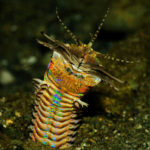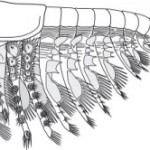Preface: After several beers at DSN central. Dr. M and I decided this needed to be reposted. Don’t ask questions. Just read it and enjoy :)
![]() Dr. Maria Pia Miglietta, a postdoc in my lab at Penn State, just published a fascinating paper on a “silent invasion” happening around the world’s oceans in the journal Biological Invasions. Those may look like tentacles, but in reality they are the nunchuks of rapid expansion of a stealthy marine invasion.
Dr. Maria Pia Miglietta, a postdoc in my lab at Penn State, just published a fascinating paper on a “silent invasion” happening around the world’s oceans in the journal Biological Invasions. Those may look like tentacles, but in reality they are the nunchuks of rapid expansion of a stealthy marine invasion.
Intonjutsu: Cheating Death

In true ninja fashion the marine hydroid Turritopsis dohrnii disappears when the going gets tough. Instead of dying with honor, they “de-differentiate” into a cyst, settle to the seafloor and reform into a benthic polyp (see figure above). The polyps then asexually bud off medusae, the jelly stage of the life cycle, thus granting this inconspicuous hydroid virtual immortality. The implications for this process, called transdifferentiation, are enormous. If T. dohrnii can withstand extreme conditions, transdifferentiation allows for unlimited travel throughout the ocean via ship’s hulls and ballast, currents or hitching a ride of some marine debris.
Hensõjutsu: Phenotypic Plasticity, The Art of Concealment
 A ninja hydroid has but one weakness – its genetic code. Miglietta and Lessios used the power of the mitochondrial 16S genetic marker to disarm the stealthy intruder. Surprisingly, little genetic structure was found among the unidentified samples from as far apart as Italy, Mallorca, Japan, Panama and Florida. Less than one half of a percent genetic difference was detected, concealed in a clade with Turritopsis dohrnii.
A ninja hydroid has but one weakness – its genetic code. Miglietta and Lessios used the power of the mitochondrial 16S genetic marker to disarm the stealthy intruder. Surprisingly, little genetic structure was found among the unidentified samples from as far apart as Italy, Mallorca, Japan, Panama and Florida. Less than one half of a percent genetic difference was detected, concealed in a clade with Turritopsis dohrnii.
 Turritopsis dohrnii from most of the world has between 12 and 24 tentacles (see above). But after measuring over 250 adults, Miglietta and Lessios found that the renegade hydrozoans living in tropical Panama always have exactly 8 tentacles (see right). The authors suggest that tropical T. dohrnii may retain a juvenile state in a process called heterochrony, defined by Stephen J. Gould as a “change in the timing of gonad development versus somatic development”. Despite this one morphological difference, the panama specimens are still genetically identical to all other T. dohrnii.
Turritopsis dohrnii from most of the world has between 12 and 24 tentacles (see above). But after measuring over 250 adults, Miglietta and Lessios found that the renegade hydrozoans living in tropical Panama always have exactly 8 tentacles (see right). The authors suggest that tropical T. dohrnii may retain a juvenile state in a process called heterochrony, defined by Stephen J. Gould as a “change in the timing of gonad development versus somatic development”. Despite this one morphological difference, the panama specimens are still genetically identical to all other T. dohrnii.
Shinobi-iri: Stealth Through Ballast
The high degree of genetic similarity suggests rapid transport throughout the marine realm between the Mediterranean and Japan, through the Panama Canal. The planktonic medusa phase of hydrozoans could explain the wide dispersal range. But with 15 identical sequences from geographically widespread localities, life history traits do not explain this extreme similarity. Miglietta and Lessios suggest that medusae may sneak into a ship’s ballast water where they can de-differentiate back into a polyp, settling on the bottom of the ballast tank. Hitchhiking along the shipping route, they asexually bud off more medusae which settle into new territory. So take heed of their warning: a true ninja species finds a way and will rapidly evolve to new situations.
See also:
Science News: Nearly Immortal Sea Creature Spreads
How to Be a Ninja
—————————————————————————
Miglietta, M.P., Lessios, H.A. (2008). A silent invasion. Biological Invasions DOI: 10.1007/s10530-008-9296-0





